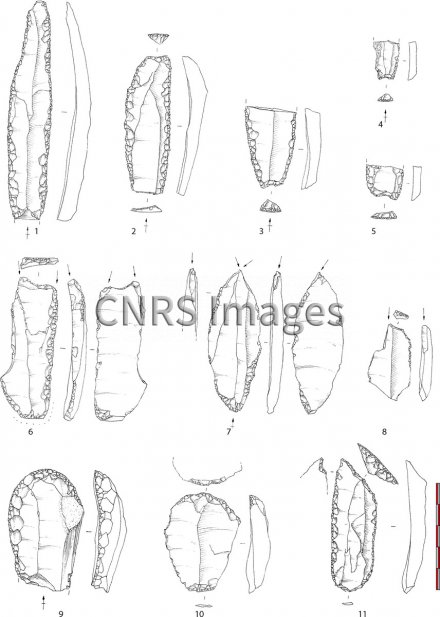Production year
2017

© Nicoas NAUDINOT / F. BLANCHET / CEPAM / PLOS ONE / CNRS Images
20170070_0003
Lithic tools discovered at the Rocher de l’Impératrice site in Plougastel-Daoulas, Finistère. This rock shelter, where digging began in 2013, was mainly occupied at the start of the Azilian, around 14,500 years ago. It was used for short periods by hunters visiting the valley that is now under the sea. Flint tools have been found there, as well as engraved schist tablets. Here, figures 1 to 5 are flat retouched blades; figures 6 to 8 are burins used to work various materials; figures 9 and 10 are scrapers; and figure 11 is a borer. Other tools have also been found, including knives and projectile points. These valuable remains provide information about the economy of the first Azilian societies, currently little documented, which developed after the Ice Age and the Magdalenian culture (Lascaux, Niaux, Font-de-Gaume, etc.). (Naudinot N, Bourdier C, Laforge M, Paris C, Bellot-Gurlet L, Beyries S, et al. (2017) Divergence in the evolution of Paleolithic symbolic and technological systems: The shining bull and engraved tablets of Rocher de l'Impératrice. PLoS ONE 12(3): e0173037.)
The use of media visible on the CNRS Images Platform can be granted on request. Any reproduction or representation is forbidden without prior authorization from CNRS Images (except for resources under Creative Commons license).
No modification of an image may be made without the prior consent of CNRS Images.
No use of an image for advertising purposes or distribution to a third party may be made without the prior agreement of CNRS Images.
For more information, please consult our general conditions
2017
Our work is guided by the way scientists question the world around them and we translate their research into images to help people to understand the world better and to awaken their curiosity and wonderment.